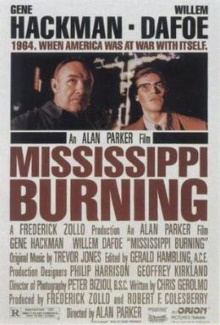
This is another of those films that I’m pretty sure I watched as a child on the television but was too young to understand much of it. There’s actually not much reason to revisit it, except that it’s emblematic of a certainly genre of films about black struggle in the US that undoubtedly has noble intentions but ends up making a hash of it because of the total lack of input from any black people and fails to respect historical facts.
Three civil rights activists, one of them black, are killed in Mississippi while organizing voter registration of African Americans. The killers are members of the Ku Klux Klan, with the backing of the local police and town authorities. FBI agents Rupert Anderson and Alan Ward arrive to investigate what is initially a missing persons case though they know that the activists are most likely already dead. They find the locals to be uncooperative, a black man they try to talk to is beaten up and later a burning cross is put up outside their motel. Ward calls in large numbers of agents and even sailors to look for clues through brute force. Anderson however advocates more subtle though also underhanded methods. He effectively seduces the wife of the a local police deputy who was directly involved in the murders into revealing the location of their bodies. When the KKK enacts wide scale retribution to terrorize the black populace, they also illegally interrogate and frame the suspects, anything to get them convicted.
The plot is loosely based on the real Chaney, Goodman, and Schwerner murders of 1964 but loosely is the operative word here as this account is heavily fictionalized. Most obviously the key witness here, the deputy’s wife is an invented character. In real life the witness was a mysterious Mr. X whose identity was kept a secret for 40 years and later revealed to a highway patrolman. The film is also bereft of many important historical details. For example, Ward is able to call upon massive resources in the course of his investigation but it is never explained that his real life equivalent reported directly to Attorney-General Robert F. Kennedy. There’s no mention that the outrage generated by this case helped the Civil Rights Act to pass. The methods that the agents are shown to employ here are ridiculous and implausible fabrications which seemed to have been added to simplify the real process of the investigation and make for a more dramatic film.
More problematic than the historical inaccuracy is director Alan Parker’s decision of which parts of the story to focus on. He puts black people on screen only to show them being mostly passive victims of brutality and violence. Meanwhile he places the dramatic weight entirely on the conflict between Anderson and Ward as they argue over how best to go about solving the case. It’s a striking case of missing the forest for the trees. Even the way that he portrays the KKK goes over poorly. Except for the very end when the good guys win, the KKK is always shown here as being scary, united and has a pervasive presence. The intended effect is to establish them as a threat but it also has the side effect of empowering them, helping them burnish their image as a genuine locus of authority and legitimacy. Meanwhile the black people here are depicted as being powerless and reliant on the FBI agents to save them. It’s no wonder that this film infuriated civil rights activists when it was released.
Flaws and all, this is still a decently made film and that helps to explain why it won so many awards at the time and was nominated for many more. It is also valuable to compare this to more recent black films such as Sorry to Bother You and of course BlacKkKlansman. It helps you to understand why these films are so highly acclaimed these days. It’s important to present things from a black perspective and to show that even while being victims, they are independent agents capable of acting for their own interests.